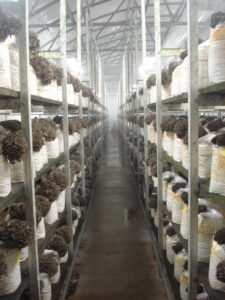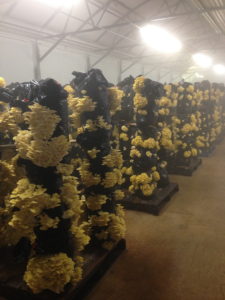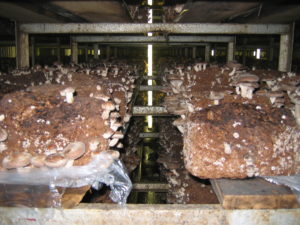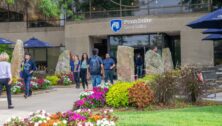Chester County Ag Notes: Healthier, Better Tasting Specialty Mushrooms

By Duncan Allison,
Mushrooms have been a traditional food in many countries. They possess valuable nutritional qualities and can serve in particular medicinal and therapeutic capacities. The most common mushroom, the white button mushroom (Agaricus bisporus) is a common grassland mushroom and is widely cultivated in the U.S.
The wood inhabiting mushrooms are much less commonly cultivated in North America and are notoriously difficult to grow because of the demanding growing conditions.

Mushrooms grow naturally in decaying trees in woodland and while they are commonly grown in other parts of the world, they are less commonly cultivated in the U.S. The culture is labor and control intensive.
For example the morel, a soil inhabiting mushroom, is highly prized in France and commands a very high price but chefs have to depend on natural supplies so the price is extremely high. Many have tried to find a successful commercial method of growing morel and other specialty mushrooms but only a few species have been commercialized successfully.
In 1979 Donald and Marshall Phillips decided to diversify their mushroom business and co-developed a method to grow shiitake mushrooms with L.F. Lambert Spawn in Coatesville, PA.
Today the Phillips Mushroom Company, still a family owned company in Kennett Square, is the largest producer of specialty mushrooms in the United States. The company continues to develop new methods and refine production procedures. They employ over 700 in Chester County and Maryland.
Entering a specialty mushroom house is very different from the more traditional white mushroom “double.” The large rooms are filled with racks. Rows and rows of individual blocks of sawdust mimic tree logs – thousands of them! Temperature is carefully controlled to ensure optimal conditions for the mycelium to permeate the sawdust and produce the mushrooms. They are all grown organically.
Since the mushroom houses are in constant production a large labor force is required to provide the constant and intensive attention. Dozens of mushroom houses are in continual production and the large labor force is required throughout the year to carry out the detailed tasks involved in producing, harvesting and packing the many different specialty mushrooms.

Tina Ellor, Technical Director, makes it clear that the production of specialty mushrooms is a “knowledge based industry that is hugely control intensive and requires specialized knowledge and specialized equipment.”
Only two specialty mushrooms grown by Phillips are being featured in this article.
Phillips has found that Shiitake mushrooms (Lentinula edodes) grow best in Northern Appalachian Red Oak sawdust substrate.
The sawdust is seasoned and then placed in special plastic bags and inoculated with mushroom spawn. After about 21 days of growing on the sawdust, the mycelium has spread throughout the bag.
The logs are taken out of their bags and moved on to racks in mushroom houses for ‘curing’ which are maintained at the appropriate temperature for optimal development.
About 21 days later the logs are immersed in water to induce mushrooms to form. This process is repeated three times for each of the three flushes produced on each log.
The mushrooms are carefully harvested each day and immediately packed at the Phillips packing plant on site and quickly transported across the nation in refrigerated trucks to the distribution centers of such companies as Whole Foods, and other major food retail and food service companies.

By contrast the oyster or yellow mushroom flourishes in a substrate of cotton seed hulls and wheat straw. The compost is also placed in small bags and inoculated with the oyster spawn and placed in one of the temperature and humidity controlled mushroom houses.
This time slits are made in the bags for the mushrooms to appear and be harvested.
Phillips also produces Maitake (Grifola frondosa) or “dancing mushrooms” in Japanese because they could be traded for their weight in silver. The rich flavor is exceptional. Try adding them to your mushroom soup, alfredo sauce or even scrambled eggs!
Maitake mushrooms are known for their immune-enhancing properties and are being used for breast cancer therapy. They require high skill levels to grow and harvest.
Phillips markets 200 fresh mushroom items which include the specialty mushrooms and have been pioneers in developing cultural methods that enable these exotic mushrooms to be grown commercially.
The market today is increasingly seeking not only different tastes but food that offers health benefits. The company has the scale and experience to benefit from this trend and utilize its experienced and committed management and skilled work force to expand its mushroom sales base further.
_________
 Duncan Allison gained degrees in horticulture and extension education in the UK and US and spent most of his career working for the DuPont Company developing and marketing crop protection chemicals. Recently he has written reports for a global ag publisher and for New Jersey-based international business consultants Kline & Co. For the last 16 years he has been heavily involved in the local farming of Chester County where he has lived with his wife and family since 1980. Contact Duncan directly via email at duncan13@comcast.net.
Duncan Allison gained degrees in horticulture and extension education in the UK and US and spent most of his career working for the DuPont Company developing and marketing crop protection chemicals. Recently he has written reports for a global ag publisher and for New Jersey-based international business consultants Kline & Co. For the last 16 years he has been heavily involved in the local farming of Chester County where he has lived with his wife and family since 1980. Contact Duncan directly via email at duncan13@comcast.net.
Connect With Your Community
Subscribe to stay informed!
"*" indicates required fields

















![95000-1023_ACJ_BannerAd[1]](https://vista.today/wp-content/uploads/2023/03/95000-1023_ACJ_BannerAd1.jpg)






























